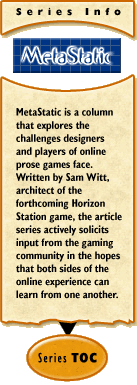 Stages and the Casual Gamer
Stages and the Casual Gamer
by Sam Witt
February 28, 2001
A year or so ago, my gaming habits changed. Due to a number of projects I'd undertaken, I went from being a hardcore gamer (devoting 20+ hours a week to gaming) to a casual gamer (squeezing in a few hours of play whenever I could grab it).
That was the first time that I really understood the plaintive cries of the casual gamer. In an environment such as online gaming, time is not only a measure of your seniority; it's the only real unit of currency. The more time you spend in the game, the better skills you have access to - both in terms of what your character can do, and how well you control that character.
When I became a casual player, I couldn't keep up with my hardcore player friends. They went on to bigger and more dangerous adventures, while I continued to hang out in the places I'd been for a few weeks. Oddly, I found myself having a bit more fun, because I was doing things in smaller doses. It wasn't taking me any longer in-game to accomplish the same tasks as the hardcore gamers, but my time was divided up so that it was taking me a week of real time to do what they did in a day or two.
This was all well and good, I was still having fun, and I kept running into new people. But, inevitably I found myself having to make new friends over and over, as the old friends spent more time in game and moved on to new areas well before my character was ready to follow.
That's one of the reasons why I like the Skotos concept of Stages. The game isn't always there, it runs at specific times for a set length, and then it closes down until the next show. It's perfect for casual gamers! The need to spend hours and hours in-game just to keep up are gone, because the game is only available for a reasonable amount of time. And if you can only play once a week, you'll still be able to play in the new stages as the come up. More importantly, you and your friends will go from stage to stage together, without having to worry about someone getting 'too far ahead.'
As designers, it's important that we keep our eye on the Stages, even when we move our games on into Grand Theaters, or even Worlds. In order to keep our casual gamers involved in the games they support, Stages should appear regularly, and be one of the prime methods of moving forward each game's storyline. By having set times when these new stages come around (once a week or so), casual gamers will be able to influence the world by taking part in important events.
Using Stages to keep casual gamers involved has the added benefit of keeping new material moving into the game environment. Assuming you create at least some new rooms for every Stage, you're not only providing material for your casual gamers, but also building up a library of areas to add to the main game.
But the most important thing to keep in mind is that casual players make up a much larger portion of your potential audience than do hardcore gamers. By creating interesting environments and storylines that capture and hold the attention of these players, you provide a much longer potential life for your creation.
See that button down below? You know what to do. See ya next week.



